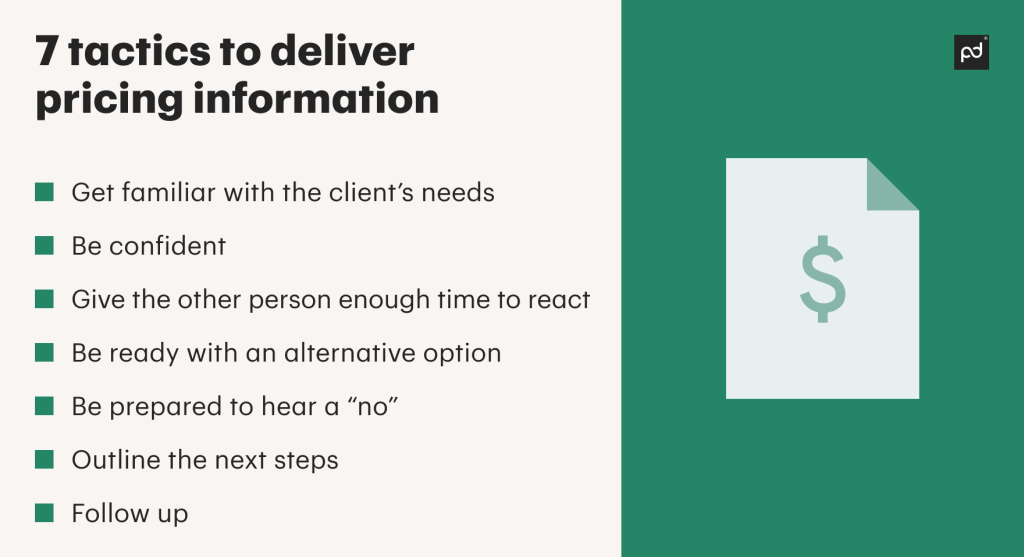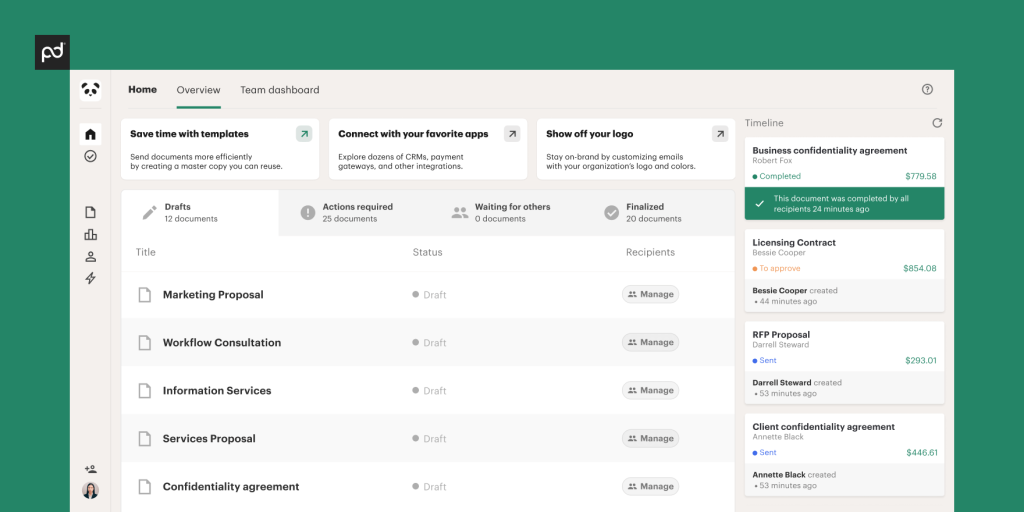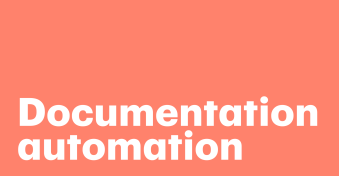Pricing is a key element of your communication with customers, and as such needs to be a central part of your dialogue with them.
Hiding your prices or being uncomfortable when you need to discuss them with clients will affect your capacity to make a sale.
This means it’s uniquely important to get the pricing right consistently and to use the proper tactics to present your prices to different audiences and decision-makers.
In this article, we’ll talk about the ins and outs of successful pricing discussions and explain how you can present pricing to clients without risking losing a deal.
We’ll also give you actionable advice you can integrate into your sales process right away and discuss the top seven tactics you can use to deliver pricing information seamlessly.
Let’s dive in — starting with the basics first.
How do you discuss pricing with clients?
Pricing information helps customers make a purchasing decision – so it’s not something you should hide or try to postpone presenting until the very last moment.
On the contrary, being upfront about pricing can help you qualify leads and spend time with prospects who are more likely to make a purchase.
And that’s a much better option than overstretching your team’s resources and talking to absolutely every lead, regardless of how slim their chance of converting is.
Of course, you need to make sure that your prospective clients understand the value of your product, so it’s important that you weave your value proposition into any discussion about prices, and talk about the benefits of what you’re offering.
So, before we get into the specifics, here are a few best practices to keep in mind.
When discussing pricing:
- Be upfront and transparent
- Talk about pricing early in the sales process
- Discuss value and pricing in parallel
- If you cannot give precise pricing information, be prepared to provide at least a rough estimate
Additionally, using the right sales enablement tools help you move faster through the contract negotiation process and deliver a good experience for your prospective customers.
These can be, for example, solid contract and sales management software like PandaDoc, and invoicing and payment tools that are intuitive for clients.
This way, both you and your prospects can have a better overview of the negotiation process and where it is currently — which makes pricing discussions simpler for everyone involved and speeds up the sales process.
When is the best time to discuss pricing?
Timing is crucial for presenting pricing in a meaningful way.
There are two key moments prospective customers need to have access to accurate pricing information:
- At the beginning of the sales process, for they to decide whether what you’re offering is within their budget.
- Before they make a final purchasing decision, to get all decision-makers on the same page.
Presenting pricing early on in your sales funnel allows leads to self-qualify and enables them to do their research independently — which is something most customers nowadays prefer (including B2B sales), according to Steven Levey from the Forbes Agency Council.
And even if you cannot give precise pricing information (because you need more information from your prospect), you can still give a ballpark figure to help them figure out what to expect.
So, make pricing an integral part of your sales process, and don’t try to hide your prices behind a string of obstacles. Because let’s face it, customers really want to know your pricing.
In most instances, you can be sure they don’t want to jump through hoops simply to figure out how much your product will cost them, or have to sit through an hour-long sales presentation to find out that your product is way out of their budget.
Pricing for high-ticket products is sometimes deliberately withheld until after a series of interactions, but a survey by HubSpot shows that, contrary to salespeople, buyers do want to talk about pricing on the first call: 58% for buyers compared to 23% of sales reps want to talk money sooner than later.
How do you send a price offer to a client?
Pricing information can definitely be discussed during sales calls, but you should always send quotes and proposals in writing, too.
This helps avoid misunderstandings or miscalculations and also gives everyone involved a clear overview of your pricing — and a better negotiation experience all around.
You can also make your offers available for a limited amount of time to incentivize your prospects to make a purchasing decision.
So, how do you actually send a price offer? There are a few ways:
- Include it in the body of an email. For simple offers including just one or two values, this might be sufficient, but keep in mind that long email threads make pricing difficult to review.
- Attach a PDF with pricing information. PDFs are easy to share over email with other decision-makers but are a bit clumsy to prepare and send out.
- Use a Google Doc with view-only permissions. You can also prepare and send out a price offer in a view-only Google Doc or Google Sheets, which makes it possible to modify during negotiations.
- Use contract management software to send an electronic proposal. A simpler alternative would be to use contract management software like PandaDoc to send a proposal in electronic form, which enables you to modify it dynamically and have it updated in real-time (and also provides a great user experience for prospects).
Whichever method you use, you need to make sure your offer is easy to review, share, and discuss with multiple people — and that you can also modify it if needed.
Top 7 tactics to deliver pricing information successfully
In this section, we’ll discuss the seven best tactics for delivering pricing information successfully.
Regardless of whether pricing information is already on your website or not, customers will still have questions and need to discuss pricing with you.
So, the best way to handle these discussions well is to come prepared.

1. Get familiar with the client’s needs
To offer your prospective clients the best pricing options (and products), you first need to understand what their pain points are and how you can help them.
This might take some time and require asking targeted questions — it’s crucial not only for the immediate deal that you’ll be negotiating but also for the entire sales process.
Relationship selling (in which you build long-term relationships with customers that extend beyond the first sale) helps build trust and loyalty — and helps you transform one-time buyers into repeat customers.
To successfully use relationship selling when talking about pricing, you need to understand your clients’:
- Initial need and main pain point
- Additional needs they might not be aware you’re able to meet
- Exact requirements and constraints
- Concerns and fears
- Decision-making process
2. Be confident
Now, we know it’s easy to simply say “be confident” and sometimes much harder to actually achieve it, but it’s true that confidence and presenting pricing successfully go hand in hand.
Here are a few ways to demonstrate confidence.
Present the value you’re providing in clear and specific terms
This way, you show your customers that (a) you know what you’re talking about, and (b) you know how exactly you can help them.
Clear, specific benefits make for a much stronger sales argument than vague statements. Which one is better: “We can help you increase organic traffic by 30% in the next 2 months”, or “We can improve your online presence”?
Don’t immediately get into lengthy explanations about your pricing
When presenting pricing info, don’t immediately jump into making lengthy explanations of why your pricing is what it is.
This will make it seem like you’re justifying yourself and aren’t certain of your value. Instead, tie value and pricing together throughout the discussion and make sure you communicate both.
Of course, if your prospective customer asks you for details, you need to give them, but don’t start with a 5-minute monologue of why your pricing structure looks the way it does.
Be ready to provide enough details
The balance between the previous point and this one can be delicate, but you need to be ready to talk about the details of your pricing (and the different options you offer) and walk your prospect through choosing the best one for them.
Just don’t immediately jump into it and overwhelm them with a barrage of explanations.
Be flexible but know when to walk out
Negotiation requires flexibility, but knowing when to walk out is essential.
If you try to cling to every lead and bend over backward to give them exactly the price they requested, you’ll look desperate rather than confident.
3. Give the other person enough time to react
Many people feel compelled to say something immediately after they present an offer, or follow up with a question such as, “Is this in line with your budget?”
Don’t.
Simply wait for the other person to react, or, put another way, let the offer “breathe.” This gives you more time to think, and it also gives the other person enough space to actually form an opinion and express it — at which point, you could start a negotiation.
Immediately asking a question, making a comment, or offering a discount gives the impression that you’re not confident in your pricing or in the worth of what you’re offering.
4. Be ready with an alternative option
Before a sales call, it’s always a good idea to have a few alternatives in mind and be ready to upsell or downsell your products.
The best way to do this is through a collaborative process in which you put your prospective customer and their needs at the center, and stay laser-focused on finding the best solution for them, both in terms of pricing, features, and timing.
If your customer is asking for a discount, don’t just give them one automatically; use this opportunity to negotiate specific terms (for example, offer a discount if they buy a yearly subscription, make a purchase in the next 48 hours, pay upfront in full, or agree to extend the delivery date).
If, on the other hand, you see that the product you initially proposed doesn’t, in fact, meet all your client’s requirements, you need to explain (and upsell) alternatives that would help them achieve what they need to.
5. Be prepared to hear a “no” (but pay attention to the reasoning behind it)
Not every “no” is equal, and not all of them are definitive: A “no” might also mean, among other things:
- We need time to think about it
- We feel overwhelmed by all the different options
- Not right now but we might purchase it soon
- We need something different
- This is above our budget but not by a lot
- We’re looking at different options and haven’t decided yet
- The main decision-maker is not on the call
- We’re not yet confident we can trust you
Uncover what stands behind the “no” to be able to move the discussion in the right direction by asking targeted follow-up questions — and giving prospects enough time to answer.
6. Outline the next steps
Explain what will happen after the call is over. For example, you’ll send a written proposal in the next 2 hours, along with a draft contract.
To get started by [date X], you need the client to eSign it by [date Y], and you’ll be able to deliver the first results on [date Z].
Sending pricing information in writing is helpful for prospective customers in another way, too: Enabling them to easily share pricing information with different decision makers and even print it out if needed is key for B2B sales, where typically at least two people are involved in the sales process on the client side.
7. Follow up
So, what comes after presenting your pricing to a client if you haven’t made a deal just yet? Following up with them, of course.
B2B sales cycles are typically longer, so not being able to secure a quick sale doesn’t mean that you should get discouraged. On the contrary, following up with prospects shows dedication and willingness to help.
Again, with the right sales software, following up is easier and faster — as is sending an invoice when the time for it comes.
And it also enables both sales reps and managers to get an instant birds-eye view of the status of a sale, as well as drill down on the smallest details, if necessary.

Should your pricing be on your website?
Sharing pricing information on your website depends on the business, sector, type of product or service, pricing structure, and on your own preferences.
In some industries, it’s very common to put pricing information on your website
In other sectors, most businesses avoid putting up pricing information online — but you might actually decide to put pricing on your website and use it as a tactic to stand out from competitors.
There are two schools of thought here.
For some, such as Marcus Sheridan, an inbound marketing expert and author of “They Ask, You Answer” (and who jump-started his marketing career through his own pool business), your pricing should always be on your website because it’s one of the most common questions people like to know the answer to.
Therefore, it helps build trust and demonstrates that you value transparency and openness.
Pricing is an essential part of research customers prefer doing even before they approach you, so giving them the right tools and information to do this research independently will facilitate and speed up the sales process.
Empowering your customers simply by providing this information on your website will (a) make a great first impression and (b) enable prospects to self-qualify.
There’s one notable exception: products or services with complex pricing structures where you need to prepare a custom estimate for each client.
If there are truly too many moving parts to set pricing, you can still include a range or a “starting at” ballpark figure.
And, if your competitors aren’t sharing pricing information on their websites, this can actually help draw more prospects to you, since prospective customers prefer the transparency that you offer rather than the awkwardness of pricing discussions.
For others, pricing, especially for high-ticket items (such as one-to-one coaching), is best discussed during a sales call, after first building rapport with the other side.
If you’re hesitating between the two approaches, you can actually test them and see which one yields better results.
For this, however, it’s important to keep all other factors constant, for example by using A/B testing (in which you change a single variable).
Because if you simply test both strategies one after another, how can you make sure that the timing of other factors (yearly sales cycles, a looming crisis, the appearance of a new competitor, etc.) isn’t skewing the results?
What’s the best way to discuss price increases with existing clients?
Price increases with existing clients are not easy to manage.
Customers have a set expectation (anchor) about how much your service should cost, and if the increase is too steep or poorly communicated you risk losing them to a competitor who is ready to price match.
For that reason, it’s essential to be upfront and transparent about price increases, and also not to begin a customer relationship with a large discount offered on the first sale — if you do, you’ll set a precedent and struggle to justify not providing similar discounts in the future.
Increase prices at specific periods that feel logical and make your increases predictable, such as at the beginning of the year or in September, after the summer holidays.
You can increase prices based on inflation, or also change your pricing structure by offering a new set of features.
Yearly increases are the easiest to manage, but you might still want to jump on a call with your most important clients to talk things through and also check in with them and make sure they’re satisfied with your product.
Using a sales management software like PandaDoc can further facilitate the process, as it helps you collect all documents and sales collateral in a single location and have customers access them easily, which, in turn, enables you to manage customer relationships efficiently (and also provide a good user experience at the same time, making everything feel more professional and smooth).
At the very least, write personalized messages to your customers (if you have a large customer base, you can automate the more repetitive parts of the process) to inform them of the increase, and give them enough notice to plan for it.
Get your pricing pitch right — and get more people to say “yes”
Pricing conversations might feel intimidating at first, but once you get the hang of it, you’ll be able to really use them as a powerful sales tool that helps you move customers from “undecided” to “eager to get started.”
Indeed, client indecisiveness is the enemy of successful deals, so making full use of your pricing pitch and improving it consistently is a key component to enabling growth.
Remember, customers want to know your prices and providing this information quickly and in the right way is in the best interest of everyone: No need to hide it or stress about it!
And if you’re equipped with the right sales management software, growth is certain.
Disclaimer
PandaDoc is not a law firm, or a substitute for an attorney or law firm. This page is not intended to and does not provide legal advice. Should you have legal questions on the validity of e-signatures or digital signatures and the enforceability thereof, please consult with an attorney or law firm. Use of PandaDocs services are governed by our Terms of Use and Privacy Policy.


